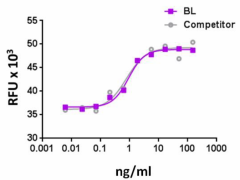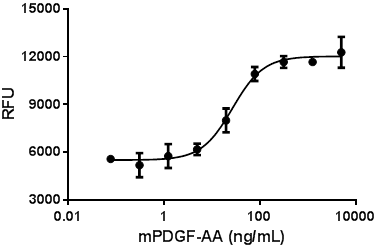- Regulatory Status
- RUO
- Other Names
- Simian sarcoma viral oncogene homolog, v-SIS, SSV, SIS, c-sis, PDGF2
- Ave. Rating
- Submit a Review
- Product Citations
- publications

-

Recombinant mouse PDGF-BB induces the proliferation of mouse NIH/3T3 cell line in a dose-dependent manner. BioLegend’s protein was compared side-by-side to the leading competitor’s equivalent product.
PDGF-BB is a mitogen that was initially identified as simian sarcoma viral oncogene homolog. It belongs to the Platelet-Derived Growth Factor (PDGF) family which includes five members: PDGF-AA, PDGF-BB, PDGF-AB, PDGF-CC, and PDGF-DD. PDGF-AA, AB, and BB dimers are processed intracellularly and secreted as active dimers that readily activate PDGF receptors (PDGFRs). PDGF-CC and PDGF-DD are secreted as full-length, latent dimers. The proteolytic removal of a CUB domain is required for the growth factor domain of PDGF-CC or PDGF-DD in order to activate the PDGFRs. PDGF-BB exerts its biological functions through the activation of dimeric receptors that are made up of two structurally similar protein-tyrosine kinase receptor subunits (αα-, αβ-, or ββ-PDGFR). PDGF has been characterized as a chemoattractant for vascular smooth muscle cells (VSMCs) from sheep and humans and for canine tracheal myocytes as well. The migration of VSMCs is critical for the maturation of nascent vessel sprouts during angiogenesis. PDGF-BB induces VSMC dedifferentiation by the down regulation of contractile protein markers and the up regulation of MMP-2. In cutaneous remodeling, studies ex vivo revealed that PDGF-BB is a mitogen and chemoattractant for dermal fibroblasts. Abnormalities of PDGFR/PDGF are thought to contribute to a number of human diseases, especially malignancy. Autocrine signaling is a consequence of PDGF-BB overexpression, which is clearly implicated in the pathogenesis of dermatofibrosarcoma protruberans (DFSP).
Product DetailsProduct Details
- Source
- Mouse PDGF-BB, amino acids (Ser82-Thr190) (Accession# NM_011057), was expressed in E. coli.
- Molecular Mass
- The 109 amino acid recombinant protein has a predicted molecular mass of approximately 12.2 kD. The DTT-reduced and non-reduced protein migrate at approximately 14 and 38 kD respectively by SDS-PAGE. The predicted N-terminal amino acid is Ser.
- Purity
- >95%, as determined by Coomassie stained SDS-PAGE.
- Formulation
- 0.22 µm filtered protein solution is in 5 mM citric acid, 10 mM NaH2PO4, 0.15 M NaCl, and pH 3.5.
- Endotoxin Level
- Less than 0.0 1ng per µg cytokine as determined by the LAL method.
- Concentration
- 10 and 25 µg sizes are bottled at 200 µg/mL. 100 µg size and larger sizes are lot-specific and bottled at the concentration indicated on the vial. To obtain lot-specific concentration and expiration, please enter the lot number in our Certificate of Analysis online tool.
- Storage & Handling
- Unopened vial can be stored between 2°C and 8°C for up to 2 weeks, at -20°C for up to six months, or at -70°C or colder until the expiration date. For maximum results, quick spin vial prior to opening. The protein can be aliquoted and stored at -20°C or colder. Stock solutions can also be prepared at 50 - 100 µg/mL in appropriate sterile buffer, carrier protein such as 0.2 - 1% BSA or HSA can be added when preparing the stock solution. Aliquots can be stored between 2°C and 8°C for up to one week and stored at -20°C or colder for up to 3 months. Avoid repeated freeze/thaw cycles.
- Activity
- ED50 = 0.5 - 2.5 ng/ml, corresponding to a specific activity of 0.4 - 2.0 x 106 units/mg, as determined by the dose dependent stimulation of NIH/3T3 cell proliferation.
- Application
-
Bioassay
- Application Notes
-
BioLegend carrier-free recombinant proteins provided in liquid format are shipped on blue-ice. Our comparison testing data indicates that when handled and stored as recommended, the liquid format has equal or better stability and shelf-life compared to commercially available lyophilized proteins after reconstitution. Our liquid proteins are verified in-house to maintain activity after shipping on blue ice and are backed by our 100% satisfaction guarantee. If you have any concerns, contact us at tech@biolegend.com.
Antigen Details
- Structure
- Cytokine.
- Distribution
-
PDGF-BB is mainly expressed in vascular endothelial cells, megakaryocytes, and neurons.
- Function
- PDGF-BB regulates diverse cellular processes including cell proliferation, transformation, migration, survival, and apoptosis of mesenchymal cells, in development and pathogenesis.
- Interaction
- Mesenchymal-derived cells, fibroblasts, and smooth muscle cells.
- Ligand/Receptor
- αα-PRGFR, αβ-PDGFR, and ββ-PDGFR.
- Bioactivity
- Induction of NIH/3T3 cell proliferation.
- Cell Type
- Embryonic Stem Cells, Hematopoietic stem and progenitors, Mesenchymal Stem Cells, Neural Stem Cells
- Biology Area
- Angiogenesis, Cell Biology, Immunology, Neuroscience, Neuroscience Cell Markers, Stem Cells
- Molecular Family
- Cytokines/Chemokines, Growth Factors
- Antigen References
-
1. Carlin SM, et al. 2003. Am. J. Physiol. Lung Cell Mol. Physiol. 284:L1020-L1026.
2. Ustach CV, et al. 2005. Mol. Cell Biol. 25:6279-6288.
3. Jones AV, et al. 2004. Cell Mol. Life Sci. 61:2912-2923.
4. Andrae J, et al. 2008. Genes Dev. 22:1276-1312.
5. Risinger GM, et al. 2010. Am. J. Physiol. Cell Physiol. 298:C191. - Gene ID
- 18591 View all products for this Gene ID
- UniProt
- View information about PDGF-BB on UniProt.org
Related FAQs
- Why choose BioLegend recombinant proteins?
-
• Each lot of product is quality-tested for bioactivity as indicated on the data sheet.
• Greater than 95% Purity or higher, tested on every lot of product.
• 100% Satisfaction Guarantee for quality performance, stability, and consistency.
• Ready-to-use liquid format saves time and reduces challenges associated with reconstitution.
• Bulk and customization available. Contact us.
• Learn more about our Recombinant Proteins. - How does the activity of your recombinant proteins compare to competitors?
-
We quality control each and every lot of recombinant protein. Not only do we check its bioactivity, but we also compare it against other commercially available recombinant proteins. We make sure each recombinant protein’s activity is at least as good as or better than the competition’s. In order to provide you with the best possible product, we ensure that our testing process is rigorous and thorough. If you’re curious and eager to make the switch to BioLegend recombinants, contact your sales representative today!
- What is the specific activity or ED50 of my recombinant protein?
-
The specific activity range of the protein is indicated on the product datasheets. Because the exact activity values on a per unit basis can largely fluctuate depending on a number of factors, including the nature of the assay, cell density, age of cells/passage number, culture media used, and end user technique, the specific activity is best defined as a range and we guarantee the specific activity of all our lots will be within the range indicated on the datasheet. Please note this only applies to recombinants labeled for use in bioassays. ELISA standard recombinant proteins are not recommended for bioassay usage as they are not tested for these applications.
- Have your recombinants been tested for stability?
-
Our testing shows that the recombinant proteins are able to withstand room temperature for a week without losing activity. In addition the recombinant proteins were also found to withstand four cycles of freeze and thaw without losing activity.
- Does specific activity of a recombinant protein vary between lots?
-
Specific activity will vary for each lot and for the type of experiment that is done to validate it, but all passed lots will have activity within the established ED50 range for the product and we guarantee that our products will have lot-to-lot consistency. Please conduct an experiment-specific validation to find the optimal ED50 for your system.
- How do you convert activity as an ED50 in ng/ml to a specific activity in Units/mg?
-
Use formula Specific activity (Units/mg) = 10^6/ ED50 (ng/mL)
 Login / Register
Login / Register 













Follow Us